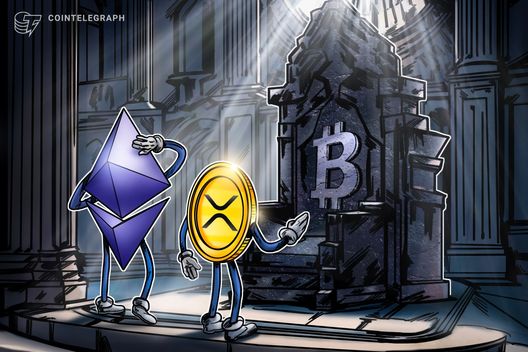

The cryptocurrency world often feels like a sprawling, interconnected metropolis, and at its heart lies a towering skyscraper: Bitcoin. For years, BTC has been the undisputed market leader, its movements often dictating the ebb and flow of the entire digital asset landscape. This dominance sparks a crucial, often anxiety-inducing question for investors and enthusiasts alike: what if Bitcoin were to crash? Would its seismic fall drag down every other digital asset, or could major players like Ether (ETH) and XRP somehow weather the storm?
Bitcoin's Unrivaled Influence: The Market's North Star
Bitcoin's position isn't just about its market capitalization, though that remains the largest by a significant margin. It's about its status as the original cryptocurrency, the digital gold narrative it has cultivated, and its role as a primary gateway for institutional money entering the crypto space. When Bitcoin surges, confidence ripples across altcoin markets; when it falters, fear often cascades, leading to widespread sell-offs.
This strong correlation stems from several factors. Many altcoins are traded against BTC pairs, meaning their value is inherently tied to Bitcoin's performance. Furthermore, Bitcoin often acts as the primary liquidity provider and the first point of entry for new capital. A significant downturn in BTC can trigger margin calls, liquidations, and a general flight to safety, where investors divest from riskier assets – including most altcoins – to stablecoins or even traditional fiat currency.
Ether's Dilemma: Utility vs. Correlation
As the second-largest cryptocurrency by market cap, Ether (ETH) stands as Bitcoin's closest rival. But unlike Bitcoin, which primarily serves as a store of value and a medium of exchange, Ether powers the vast Ethereum ecosystem, a decentralized network home to countless decentralized applications (dApps), DeFi protocols, NFTs, and smart contracts. This fundamental utility often leads to discussions about whether ETH could decouple from BTC.
Historically, Ether has shown a strong correlation with Bitcoin's price movements. When BTC falls, ETH often follows, albeit sometimes with less severity or with a quicker recovery. However, Ethereum's ongoing upgrades, such as the transition to Proof-of-Stake (the Merge) and future sharding implementations, aim to enhance its scalability, security, and sustainability, potentially strengthening its independent value proposition. The sheer utility and robust developer community behind Ethereum suggest it has a deeper intrinsic value beyond mere speculation. While a BTC crash would undoubtedly hit ETH hard, its extensive ecosystem and real-world applications might provide a stronger floor and a faster path to recovery compared to less established altcoins.
XRP's Unique Position: A Different Path?
XRP, the native cryptocurrency of the Ripple network, presents an even more distinct case. Designed primarily for fast, low-cost international payments and remittances, XRP aims to disrupt traditional banking infrastructure rather than compete directly with Bitcoin as a store of value. Its primary utility lies within the RippleNet, a global payments network used by financial institutions. This enterprise-focused utility, coupled with its highly centralized origins compared to BTC and ETH, sets it apart.
XRP's price has often been influenced by its ongoing regulatory battles, particularly the lawsuit with the U.S. Securities and Exchange Commission (SEC). Positive developments in this legal saga have historically led to significant price pumps, demonstrating that external factors beyond general market sentiment can strongly impact its valuation. While XRP has historically shown correlation with the broader crypto market, its specific use case and corporate adoption might offer some insulation against a pure speculative BTC crash. Financial institutions using RippleNet might continue to require XRP for cross-border transactions, potentially creating a demand floor independent of broader crypto market sentiment, though panic selling from retail investors would still be a significant factor.
The Ripple Effect: Broader Market Contagion
A significant Bitcoin crash wouldn't just be a localized event; it would send shockwaves across the entire crypto market. Investor confidence would plummet, potentially leading to mass withdrawals from exchanges, increased regulatory scrutiny, and a general exodus of capital from the digital asset space. Smaller altcoins, often highly dependent on speculative interest and liquidity flowing from Bitcoin, would likely face catastrophic losses, with many struggling to recover.
The interconnectedness of the crypto economy means that even assets with strong fundamentals or unique utility are rarely immune to such a seismic event. However, those with established use cases, robust communities, and clear development roadmaps—like Ether and, to a lesser extent, XRP—might demonstrate greater resilience in the long run. They could recover more quickly once the initial panic subsides and investors begin to differentiate between speculative assets and those offering genuine value.
Navigating the Uncertainty: Diversification and Due Diligence
Ultimately, while a Bitcoin crash would undoubtedly be a challenging period for the entire cryptocurrency market, the degree to which Ether, XRP, and other altcoins are affected isn't uniform. Assets with strong utility, active development, and a clear vision for their role in the future of finance and technology are better positioned to weather such a storm than purely speculative projects.
For investors, this hypothetical scenario underscores the importance of diversification, understanding the fundamental value propositions of each asset, and practicing rigorous risk management. The crypto market is dynamic and inherently volatile, and while Bitcoin remains its primary driver, the increasing maturity and utility of other digital assets suggest a future where genuine innovation might offer a path to greater independence.
Keywords: Crypto
